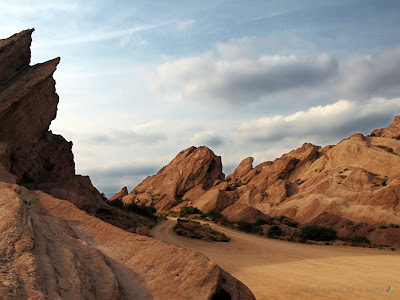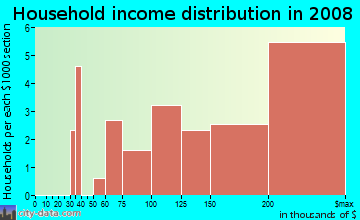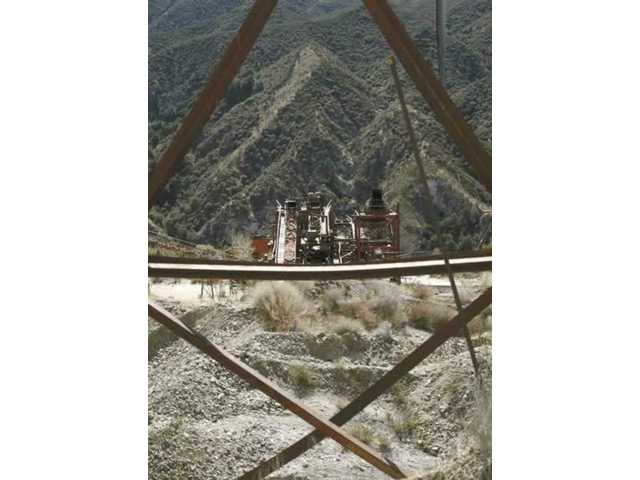Santa Clarita is close to the Southern Pacific Coast and the climate is the exact opposite of the northern Pacific Coast. The annual average precipitation in Santa Clarita is 17.96 Inches. Winter months tend to be wetter than summer months. The wettest month of the year is February with an average rainfall of 4.32 Inches. Due to the low amounts of percipitation, Santa Clarita does not have rainforests.
Santa Clarita has hot dry summers. The warmest month of the year is August with an average maximum temperature of 95.40 degrees Fahrenheit, while the coldest month of the year is December with an average minimum temperature of 35.80 degrees Fahrenheit.
EARLY SETTLERS OF THE SANTA CLARITA VALLEY:

The Tataviam:
Early Newhall Residents.
By Paul Higgins, Environmental Educator.Early Newhall Residents.
In AD 450, a small group of Shoshone-speaking people migrated to the Santa Clarita Valley. The Kitanemuk Indians, who lived in the
The name derived from their words taviyik, or "sunny hillside," and atavihukwa, or "he is sunning himself." Thus the word tataviam might be roughly translated as "people facing the sun" or "people of the south-facing slopes."
The Tataviam were more aggressive than the Chumash, who lived here at the time and encouraged them to move west down the
The Tataviam lived in approximately twenty various-sized villages within the upper reaches of the
Some areas they occupied were Nuhubit (Newhall), Piru-U-Bit (Piru), Tochonanga — believed to have been located at the confluence of Wiley and Towsley Canyons — and the very large village of Chaguibit, the center of which is buried under the Rye Canyon exit of I-5.
The Tataviam also lived where
Southern California offered the Tataviam the most abundant natural food supply in
Deer, rabbits, squirrels, birds, lizards, snakes, grasshoppers and caterpillars were hunted and trapped for food. Acorns, yucca, toyon berries, chia seeds and buckwheat were eaten regularly. Few if any nonagricultural peoples in the world were able to draw on so many food sources.
Life was good for the Tataviam. They were among the most ingenious, industrious and peaceful Indians of North America. They lived an honest life without laws, money, jails or a welfare system. They had no bad spirits, and before the missionaries came in 1769, they had no concept of hell or the devil. They did not change the land, but rather adapted themselves to it.
On May 2, 1884 a young man named McCoy Pyle discovered a cave in the hills above the present Chiquita Canyon Landfill, north of Highway 126. Inside he found many large woven baskets containing stone axe heads, obsidian knife blades, crystals, whistles made from deer bones, headdresses and capes made of iridescent condor and flicker feathers, and four ceremonial scepters consisting of painted stone discs attached to wooden handles.
Stephen Bowers purchased the entire collection for $1,500. Bowers sold the items to private collectors all over the world. Some of the "
Some small displays of Tataviam artifacts can be seen at the
Bedrock mortar areas, pictographs and middens can still be found in undeveloped areas of the valley. It is still common to discover stone points after rainstorms.
Who knows? Perhaps there is another large stash of Tataviam treasure still hidden in a cave somewhere in the Santa Clarita Valley, just waiting to be found!
http://www.scvleon.com/newhall/tataviam.htm
HIKING IN THE SANTA CLARITA VALLEY:

27201 Pico Canyon Road, Newhall, California, 91381
HIKING IN THE SANTA CLARITA VALLEY:

27201 Pico Canyon Road, Newhall, California, 91381
Santa Clarita Woodlands Park - Pico Canyon
Pico Canyon, located in the northern portion of the Santa Clarita Woodlands Park, is home to a rich and active oil history. Explore the remaining historic buildings of Mentryville, an oil boom town. Pico Canyon features large valley and coast live oaks, chaparral-dominated slopes, and views of Santa Clarita.
Santa Clarita Woodlands Park – Ed Davis Park at Towsley Canyon
24255 The Old Road, Newhall, California
Ed Davis Park in Towsley Canyon, named for former State Senator Ed Davis, who championed the preservation of Towsley Canyon, offers visitors a peaceful haven just west of the I-5 between the Santa Clarita and San Fernando Valleys. Trails for hiking, mountain biking, and equestrian use lead visitors through an astonishing variety of habitat types. Notable park features include spectacular water-worn rock formations in Towsley Gorge, year-round Towsley Creek, scenic trail viewpoints, and oak woodland.
Ed Davis Park in Towsley Canyon, named for former State Senator Ed Davis, who championed the preservation of Towsley Canyon, offers visitors a peaceful haven just west of the I-5 between the Santa Clarita and San Fernando Valleys. Trails for hiking, mountain biking, and equestrian use lead visitors through an astonishing variety of habitat types. Notable park features include spectacular water-worn rock formations in Towsley Gorge, year-round Towsley Creek, scenic trail viewpoints, and oak woodland.
Santa Clarita Woodlands Park - East Canyon, Rice Canyon, and Michael D. Antonovich Open Space
23801 The Old Road, Newhall, California
23801 The Old Road, Newhall, California
East and Rice Canyons are home to the Santa Clarita Woodlands' richest and lushest vegetation. The trailhead provides parking, restrooms, and picnic area. A hike on the 3.8 East Canyon trail takes one through three species of oak. California bay laurel, California black walnut, and bigleaf maple, up in elevation to a unusual forest of big cone Douglas fir. The dirt fire road leads hikers, mountain bikers and equestrians on a steady climb to magnificent views of Santa Clarita Woodlands Park and the Santa Clarita Valley. The trail leads into the over 400-acre Michael D. Antonovich Open Space which straddles the ridgeline of the Santa Susana Mountains. Rice Canyon Loop Trail is an easy to moderate 1.2 mile trail along Rice Creek for hikers only.
These are maintained by Mountains Recreation and Conservation Authority, a subsidiary of the Santa Monica Mountains Conservancy. Each provides a great look at plants and animals that thrive in our unique Mediterranean environment.
Towsley, in particular, affords unique possibilities. It has burned twice in the last 10 years, giving us an opportunity to see how ecosystems come back from this type of “disaster”. There is a small stream for a look at riparian communities, as well as very cool geological stuff. This is the site of a natural oil field, and some of the oil still exists in pools you can spot along parts of the trails. I recommend this particular hike for plant ecology, and birding.
TREES:

Santa Clarita is home to tens of thousands of native oaks which blanket our local mountains, line our streams and add a beautiful presence to our natural landscape. These native oak trees have a long history in Santa Clarita which date back to the 1800’s.
Urban Forestry maintains all of the City's street, park, trail, and facility trees, while planting many more each year. Trees enhance the quality of life in Santa Clarita by providing beautification and improving the air quality. The Division is responsible for the maintenance of 50,000 trees, reforestation, weed abatement, the Neighborhood Leaf Out Program, neighborhood plantings, the Arbor Day celebration, plancheck, review of plantings, and removal of trees. Contact Urban Forestry at (661) 294-2567.
Santa Clarita ’s Oak Tree Ordinance (No. 89-10) is the mechanism by which the City of Santa Clarita draws its authority to regulate the pruning, encroachment, and removal of oak trees within the City of Santa Clarita
The businesses located in Santa Clarita can be categorized as small businesses with 59% employing less than 5 employees. Businesses between 5 and 9 employees account for 19% of all businesses in the City and only 5% employ in excess of 50 employees.Urban Forestry maintains all of the City's street, park, trail, and facility trees, while planting many more each year. Trees enhance the quality of life in Santa Clarita by providing beautification and improving the air quality. The Division is responsible for the maintenance of 50,000 trees, reforestation, weed abatement, the Neighborhood Leaf Out Program, neighborhood plantings, the Arbor Day celebration, plancheck, review of plantings, and removal of trees. Contact Urban Forestry at (661) 294-2567.
General Information
In September 1990, as directed by the Ordinance, the City Council passed the Oak Tree Preservation and Protection Guidelines. This document established the administrative procedures and rules for the implementation of the Ordinance.
As a matter of general practice, the City of Santa Clarita
Streamline the Current Oak Tree Permit process.
- Examine the distinction in the permit application process between individual residents and developers.
- Examine the current fee structure associated with the Oak Tree Permit process.
- Examine the development of an oak tree re-forestation program and tree tracking system.
- Update any and all language and/or terminology in both documents that is no longer current.
- Develop a public education strategy regarding the preservation and protection of oak trees.
Staff was also directed to receive input from the public regarding all of the items listed above. The purpose of this website is to provide information on the status of the process to revise the Ordinance as well as the Guidelines, and to provide an opportunity for members of the community to provide the City with their comments.
ECONOMY IN SANTA CLARITA:
ECONOMY IN SANTA CLARITA:
BUSINESS ENVIRONMENT
Santa Clarita’s local economy is primarily a service based economy with 41% of the businesses in the service sector. An additional 21% of businesses are in retail trade and 10% each are in the finance, insurance, and real estate sector as well as construction.
WORKFORCE
Close to two in four or 38% of the workforce in the City of Santa Clarita is employed in the services sector. An additional 25% of the City’s workforce is employed in retail trade followed by 9% in manufacturing, 8% in construction, 7% in finance/insurance, and real estate industries, and 6% in wholesale trade.
More than one-fourth or 26% of the City of Santa Clarita’s workforce are in professional or specialized positions while another 21% are in administrative and support positions, 14% are in marketing or sales, and 11% are in executive roles.
One-third or 32% of Santa Clarita Valley’s manufacturing workforce is employed in aerospace with an additional 18% in computers and electronics and 14% in biomedical manufacturing.
Based on an independent study of 367 communities across the United States by the Kosmont-Rose Institute, cost ratings were developed in order to compare difference communities based on business taxes, telephone taxes, sales taxes, property taxes, electric taxes, and state income taxes.
Santa Clarita is ranked as Low Cost ($$) compared to the Cities of Los Angeles and Pasadena which are both ranked as Very High Cost ($$$$$). Out of 224 California cities, Santa Clarita is ranked as the 11th lowest cost city in Los Angeles County.http://www.santa-clarita.com/index.aspx?page=583
FILMING IN SANTA CLARITA:
Santa Clarita's topography lent itself to early filming. Silent screen stars like William S. Hart and Tom Mix used the valley to create the traditions that would define the "Western."

SEE WHAT'S HAPPENING NOW IN SANTA CLARITA!
http://www.youtube.com/cityofsantaclarita#p/u/0/wsBRUItyQmU



















